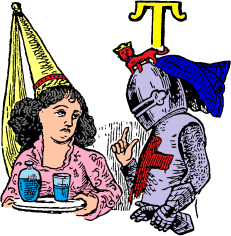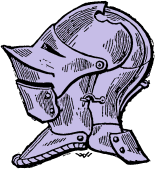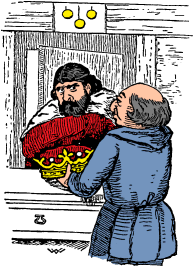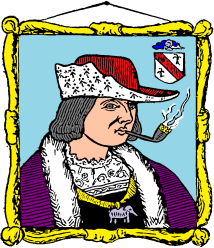HOME
Preface
Introduction
1
2
3
4
5
6
7
8
9
10
11
12
13
14
15
16
17
18
19
20
21
22
23
XIV
CHAPTER XIV.
OF HELMETS AND OTHER WONDERFUL THINGS.
HE Heraldic Shield, like the House of Commons, has two sides--an inside and an outside. Having now exhausted the list of the principal articles to be found inside the shield, we will proceed to treat of those external articles,--which, like other mysterious puzzles, are to be found out.
Of these external ornaments, the principal are helmets, crowns, halfcrowns or coronets, wreaths, crests, mitres, scrolls, supporters and mottoes.
First of all, we have the Helmet; which, appertaining literally to the head of the family, was naturally a most important item in the Heraldic system. The helmet was always placed on the top of the shield, and varied according to the rank of the owner. That belonging to the king is of gold, which is naturally the correct material for a sovereign. It is full-faced and open, with six bars. Considering the very few bars formerly placed upon the actions of kings, and great men generally, those on the helmet clearly derived their origin from the lucus a non lucendo principle. A ducal helmet is of steel, and defended with five gold bars: from which we may note that, like publicans, both kings and dukes were always to be found behind their bars.
The helmet of a baronet or knight is also of steel, full-faced, the visor up, and without bars; their countenances being thus totally uncovered it may naturally be inferred that this class of warriors were a decidedly barefaced lot. Esquires and gentlemen have also steel helmets with the visor down, ornamented with gold, and placed in profile, the faces in this instance being concealed: this class was probably more modest than the former, apt to turn aside, and easily shut up, if, at any rate, they followed the examples of their visors.
On a well-regulated coat of arms, a crown, coronet, or wreath invariably surmounted the helmet. Crowns, of course, belong to kings--though sometimes we have had them, or their equivalent in shillings, in our possession ; but unluckily they never stay long.
The first crowns were simply bands or fillets, which latter word reminds us naturally of butchers' meat; and considering they were not unfrequently bestowed upon those who had benefited the common weal or veal, the connection is not so remote as at first sight might appear. Afterwards, they were composed of branches of various trees, which shows that ideas about that time began to sprout, though, to modern minds, the notion of a wooden crown would only be suitable to persons possessing a head of a similar texture. Next, flowers were added to the crown, so that a conquering hero in the middle ages must have presented an absurd mixture of the warrior and the nursery gardener combined.
To pass, however, to more known times. Constantine the Great first used a diadem of pearls and precious stones over a gold helm, somewhat like the close crowns of later times, which seems to have set the example the sovereigns afterwards followed.
Crowns, as a rule, are composed of a circle of gold round a velvet cap, therein differing from coronets, which are not covered at the top. Hence the expression "to close the crown," used to be synonymous with the assumption of royal prerogatives, just as now-a-days, in a humbler grade of life, the expression to "shut up shop," is equivalent to the assumption of private life after the fatigue of selling small coal and mealy potatoes. This action of closing the crown was thus one performed by those princes who felt themselves strong enough to set up in business as kings on their own account.
The royal crown of England consists of a circlet of gold enriched with jewels and heightened by four crosses, and four fleur-de-lis alternately. It is really a neat thing in crowns, and in cases of emergency, as King John found in impecunious days, a deal can be made of it. He made a deal with it, and raised some money on it.
The Prince of Wales has only a coronet, consisting of a circle of gold, set with crosses and fleur-de-lis. As, however, it is not covered in, it must on the whole be a drafty kind of head-piece; which, perhaps, accounts for His Royal Highness usually preferring a modern hat, or at any rate a wide-a-wake, when out of doors. Not having ever worn a coronet, we cannot, however, speak with certainty on this point. Ascending from the coronet are three ostrich feathers, which, perhaps, denote that the Prince is always in good feather.
The younger sons and brothers of sovereigns have coronets diversified with crosses and strawberry leaves. A duke has merely eight strawberry leaves. And here we shall inform those of our readers who may not happen to be acquainted with the manners and customs of the "upper ten," upon a point of breeding most requisite to be observed should they be summoned, as most probably some of them will be, to the House of Lords.--[No extra charge is made for the information ; it is included in the price of the present volume.]--In consequence of the strawberry leaves adorning a ducal coronet, it is regarded as a delicate attention, when addressing anyone of the rank, to mention him as "Leaves," or, in case you should desire to be very ceremonious, to address him as "Pottle," at once. This will invariably ensure favourable notice from the party (and a duke is a very large party indeed) spoken to.
We shall rapidly dismiss the other decorations, by stating that a marquis's coronet has two balls and two strawberry leaves; that of an earl, five balls only; a viscount, any quantity of balls you like to stick on; but, as a rule, either seven or nine balls; and a baron, who is the smallest kind of peer--a sort of stepping-stone, in fact,--only rejoices in four balls to his coronet. A pawnbroker has three balls; but as, for reasons of state, he does not usually wear a coronet, he places them, for convenience, outside his dwelling. As a rule, he is not a peer.
Besides crowns and coronets, we have also "Mitres," and "Chapeaux." The former of these belong exclusively to bishops, who, as pillars of the Church, also do their best, as clerical peers, to support the Establishment.
The "chapeau," or "cap of maintenance," was orignally borne by dukes only, and was placed beneath the crest, serving sometimes in place of a wreath, of which more in our next. Afterwards the chapeau, like patents that have run out, became common property, and appeared in all sorts of unexpected shields. It is generally of velvet, scarlet in colour, turned up with ermine, and when not in use Heraldically, will serve as a smoking-cap.
XIV
1
2
3
4
5
6
7
8
9
10
11
12
13
14
15
16
17
18
19
20
21
22
23
Preface
Introduction
HOME
Build: 2019/04/20 14:20:08.59+0900(JST)





